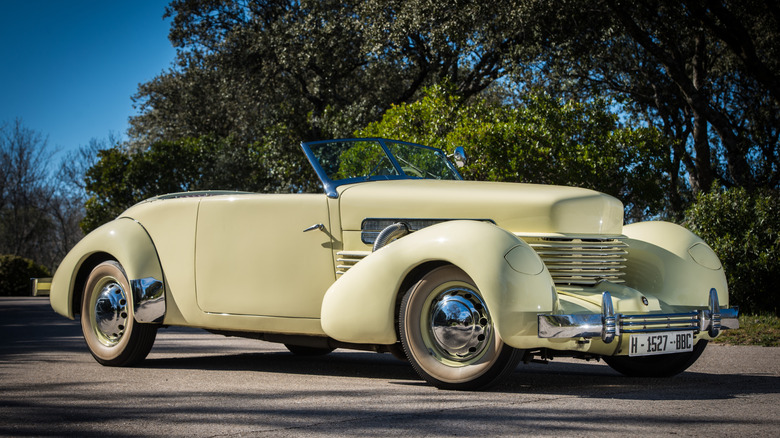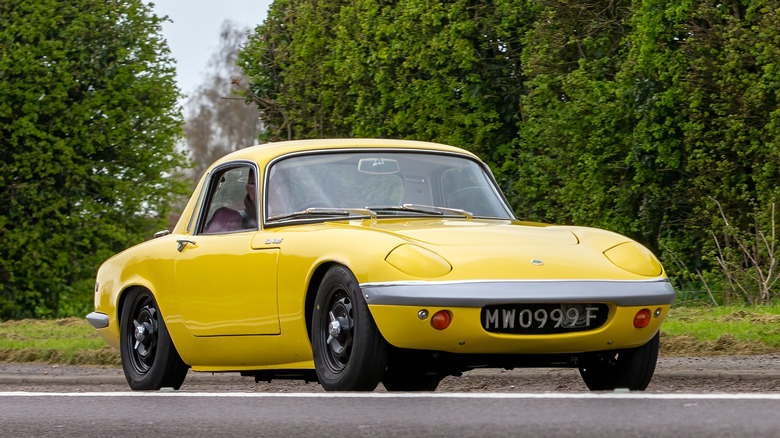Which Classic Car Had The First Pop-Up Headlights?
Pop-up headlights were all the rage back in the age of the aerodynamic 1980s wedge-shape design. They offered vehicles a sleek, cohesive hood line and an undeniable "cool-factor" when the sun set, with various stellar models like the Ferrari Testarossa, Toyota MR2, Chevrolet Corvette, and many others popularizing the look worldwide. After the demise of the sealed-beam headlight and the birth of new regulations regarding pedestrian safety, however, pop-up headlights quickly became a thing of the past. The last vehicle to ever use them left the factory on July 2, 2004 – a C5 Corvette. In February earlier that year, the only other model still using them, the Lotus Esprit, also ended its production run, spelling the end of the pop-up headlight. But one thing's actually rather unclear: What was the very first car to use them?
The reason why is because we first have to establish what's meant by the term "pop-up headlight." Typically we think of the pop-up headlight vertically rising out of the hood – the earliest example of a production car using this design in a powered configuration is the 1962 Lotus Elan. Powered by vacuum tubes, the Elan's headlights weren't exactly the most reliable thing in the world – but they were effortlessly cool. Even before then, however, other cars did actually feature "pop-up" headlights – or, more accurately, "hidden headlights." These date back to the shrouded headlights incorporated into the fenders of the 1936 Cord 810: a car with headlights you had to manually crank to operate.
The true pioneer: 1936 Cord 810
The first patent for a true retractable headlight was filed by Harold T. Ames, vice-president of Auburn, on July 19, 1934 for the upcoming Cord 810. This car was a true innovator in a number of ways, based on early "Baby Duesenberg" prototypes and aimed towards the mid-upper class market. Motoring pioneer E.L. Cord originally intended this vehicle to be a Duesenberg, in fact. But after being passed around by different manufacturers under the Cord conglomerate, it finally wound up wearing the name "Cord," debuting for the 1936 model year.
The original designers, led by Gordon M. Buehrig, intended its distinctive headlights to utilize electrical power. But this was the mid-1930s, and that was simply too cost-prohibitive (even for a Doozy). Hence, the very first pop-up headlights didn't actually "pop up," rather they "cranked up" with two mechanical cranks on either side of the dashboard linked to a series of pulleys and cables.
Despite its rather cumbersome start, the Cord 810 and 812 introduced an incredibly distinct style – bear in mind that this was a time when cars like the Ford Model A were the perennial sight on American roads. Manufacturers were only just exploring the principles of aerodynamic construction, with almost all design considerations still favoring style and functionality over form-factor. Absolutely nothing looked like these cars, certainly not in the late-1930s. Before long, GM began experimenting with their own designs utilizing hidden headlights, such as the 1938 Buick Y-Job: America's first ever concept car, and truly ahead of its time. However, this template wouldn't fully come into vogue for several decades.
The first actual pop-up headlight: 1962 Lotus Elan
With a career spanning from 1962-1975, the first-generation Lotus Elan was as prolific as it was influential in the world of small, lightweight sports cars, practically setting the template that Lotus would follow for the rest of the 20th century. It was fast, inexpensive (just $1,700 when new), and stylish, featuring the first ever pop-up headlights of its type on a production car. The only model which truly preceded its style was the early-1950s Siata 208 CS – though they weren't exactly common. Only 11 of the 18 built were ever fitted with the pop-up headlights, hardly a "production" car as-such.
The Elan was principally designed as an ultra-lightweight street-legal go-kart, originally fitted with a 1.5L and later 1.6L Ford DOHC inline-four mated to a basic 4-speed manual gearbox. And frankly not much else; this thing only weighed about 1,500 pounds, up to an Earth-shattering 2,000 pounds for the Elan +2. They weren't exceptionally powerful, but their outstanding handling made them prolific race cars.
As mentioned before, the Elan utilized a vacuum system to control its headlights. As such, while its system represented the first pop-up headlight, it wasn't the first to use modern electrics to actuate them. That title instead goes to the 1963 Chevrolet Corvette C2, which uses a proprietary electrical system to spin the headlights. But that's arguably not a "pop-up" as such; the first true pop-up headlight with an electric motor powering it was the 1967 Maserati Ghibli. Basically, the story behind pop-up headlights is deceptively complex, and the question of "which is first" has multiple correct answers. But behind every one of them is undoubtedly a storied, interesting machine.


